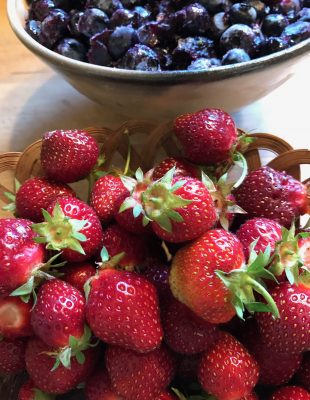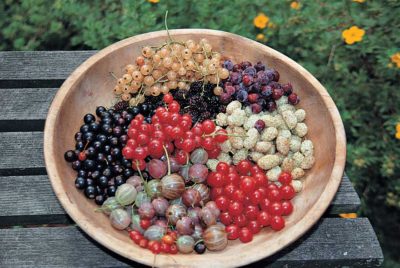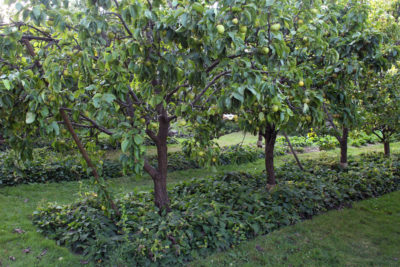BERRIES & ASPARAGUS REDUX
Berry Enticing
Berries are making it harder to get things done around here. Not because they are so much trouble to grow, but because I’ve planted them here, there, and everywhere. Wherever I walk I seem to come upon a berry bush. Who can resist stopping to graze? This year is a particular bountiful year for berries.
I can’t even walk to my mailbox without being confronted. First, there are lowbush blueberries hanging ripe for the picking over the stone wall bordering the path from the front door.  The wall supports the bed of them planted along with lingonberries, mountain laurels, and rhododendrons. These plants are grouped together because they are in the Heath Family, Ericaceae, all of which demand similar and rather unique soil conditions. That is, high acidity (pH 4 to 5.5), consistent moisture, good aeration, low fertility, and an abundance of soil organic matter. The small blueberries send me back to many summers ago in Maine when a very young me hiked in the White Mountains and picked these berries from plants growing amongst sun-drenched boulders. Care needed: mulching in autumn, and cutting a portion of the planting to the ground with a hedge trimmer every second or third winter.
The wall supports the bed of them planted along with lingonberries, mountain laurels, and rhododendrons. These plants are grouped together because they are in the Heath Family, Ericaceae, all of which demand similar and rather unique soil conditions. That is, high acidity (pH 4 to 5.5), consistent moisture, good aeration, low fertility, and an abundance of soil organic matter. The small blueberries send me back to many summers ago in Maine when a very young me hiked in the White Mountains and picked these berries from plants growing amongst sun-drenched boulders. Care needed: mulching in autumn, and cutting a portion of the planting to the ground with a hedge trimmer every second or third winter.
A few feet further the path ends and I come to the driveway, and here’s a 50 foot long hedge of Nanking cherries (berry size, but a drupe fruit, not a berry), whose season is almost over. For the past few weeks the stems were so solidly clothed in cherries that you could hardly see the branches. The cherries have a very refreshing flavor on the spectrum between that of sweet and tart cherries. Care needed: winter pruning — very nonexacting — to keep the bushes from growing too large.
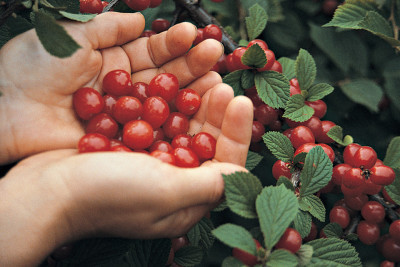
Perhaps later, once back in the house, I’ve got to walk out the back door to the compost pile. Hmmm. Gooseberry plants are enticing me with their stems that are arching to the ground under their weight of berries. Can’t pick a little from just one plant. I’ve got to eat a few of each of the over dozen varieties. My favorites? Hinnonmaki Yellow, Poorman, Black Satin, Red Jacket, and Captivator.
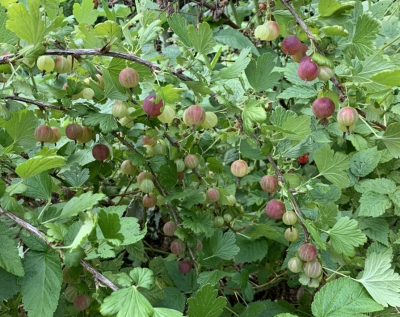
Poorman gooseberry
It’s a funny thing about gooseberries. If I pick a bowl of the berries and then bring them indoors to eat, they don’t taste as good as the one’s eaten bushside. It’s not just me; Edward Bunyard, in his 1929 book The Anatomy Of Dessert, wrote that the “Gooseberry is of course the fruit par excellence for ambulant consumption.”
Care needed: winter pruning to get rid of the very oldest stems and make way for younger ones; and to reduce the number of newest stems if they are overly abundant.
Okay, I finally made it to the compost pile. Now to check what’s going on in the greenhouse. Uh oh, I have to walk past black currants, one of my favorite fruits and now at their peak flavor. Their flavor is intense, intensely delicious to me. I grow mostly the variety Belaruskaja, which has just the right amount of sweetness to balance its almost resin-y flavor. Care needed: annual winter lopping to the ground of all two-year-old and some one-year-old stems.
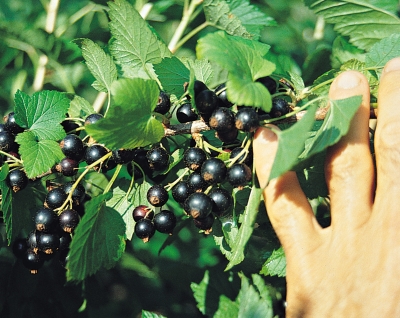
And right next to the black currants are black raspberries, also now at their peak flavor. The heavy crop of berries are arching some of the longest stems within reach of our ducks. I can share a few berries with them. Black raspberries grow wild all over the place in much of this part of the country. Wild ones are good. I prefer the named variety, Niwot, that I planted because it is one of two varieties that can bear two crops each season. For fruit size, flavor, and abundance, it’s worth growing even for just its summer crop. Care needed: summer pinching of tips of new stems to induce branching; winter pruning to cut away all two-year-old stems and thin out one-year-old stems, and to shorten branches to 18 inches; and tying stems to posts to hold them up.
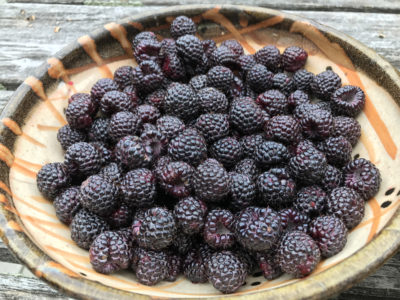
Finally, I make it to the greenhouse. Leaving it, I’m confronted with two mulberry trees, the variety Illinois Everbearing and the variety Oscar (what a funny name for a fruit tree). No danger of the mulberries delaying my progress because I know that the birds are taking all of them. Illinois Everbearing, true to its name, will continue to bear into August. Perhaps by then the birds will tire of them or move on to other fruits, leaving some for me.
One more enticement, one of the best, before going back indoors — Fallgold raspberry.  This variety, carrying genes of some species of Asian raspberry, has a sweet, delicate flavor unlike any other variety. Physically, the berries are similarly sweet and delicate, a pale, pinkish yellow. Their fragility makes them a poor commercial fruit so you won’t see them for sale. Grow them.
This variety, carrying genes of some species of Asian raspberry, has a sweet, delicate flavor unlike any other variety. Physically, the berries are similarly sweet and delicate, a pale, pinkish yellow. Their fragility makes them a poor commercial fruit so you won’t see them for sale. Grow them.
Asparagus Cutting?
Seems like last week’s blog post about my method for reducing weeds in the asparagus patch caused a lot of confusion. I wrote that I cut down all the spears before applying compost and wood chips, and many people thought that was not supposed to be done until autumn.
During the harvest season, which here is from the time the spears first show until the end of June, the spears are constantly being cut down for eating. All are regularly cut, even those too spindly for eating. Doing so helps starve out asparagus beetles, which are gone by July.
So consider my final, early July lopping back of any and all spears just like a final harvest. From then on, spears are left grow to their heart’s content, fueling the roots for next year’s spring and early summer harvest. The bed gets its final cutting down in autumn, when the ferns yellow to indicate that they’re no longer feeding the roots.
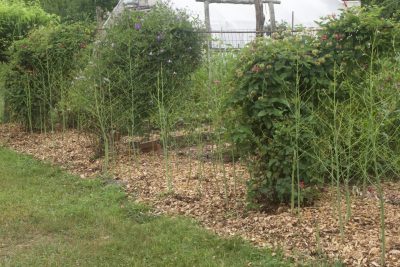
I was a little nervous about the compost plus wood chip smothering asparagus plants in addition to weeds. Not to worry. It’s a few days after the treatment and some fronds are already a few feet high. And so far, no weeds.
More details about growing and use of berry (and other) fruit plants can be found in my books Grow Fruit Naturally and Landscaping with Fruit.


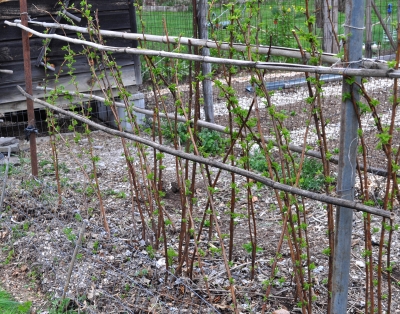

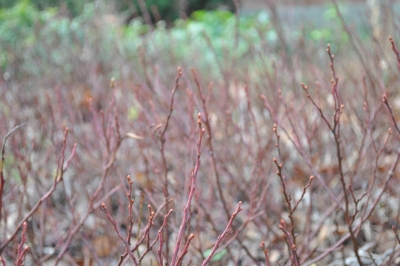
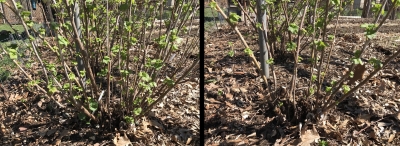
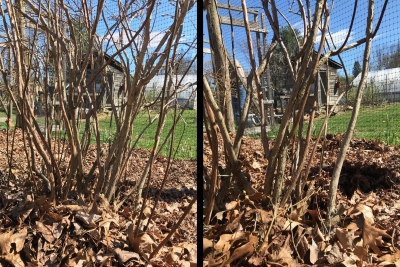
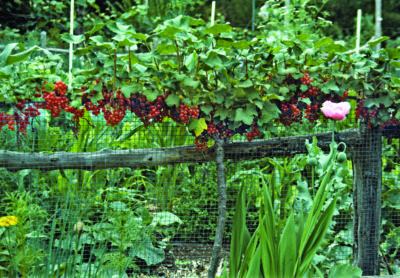
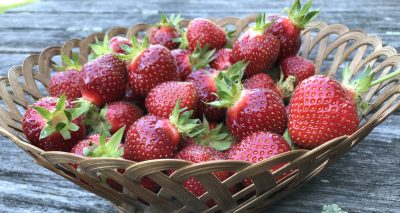
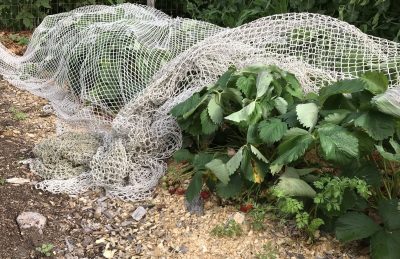 Once Earliglow stops bearing for the season, the bed will need renovation and, through the season, its runners pinched off weekly to keep each plant “spacey.”
Once Earliglow stops bearing for the season, the bed will need renovation and, through the season, its runners pinched off weekly to keep each plant “spacey.”